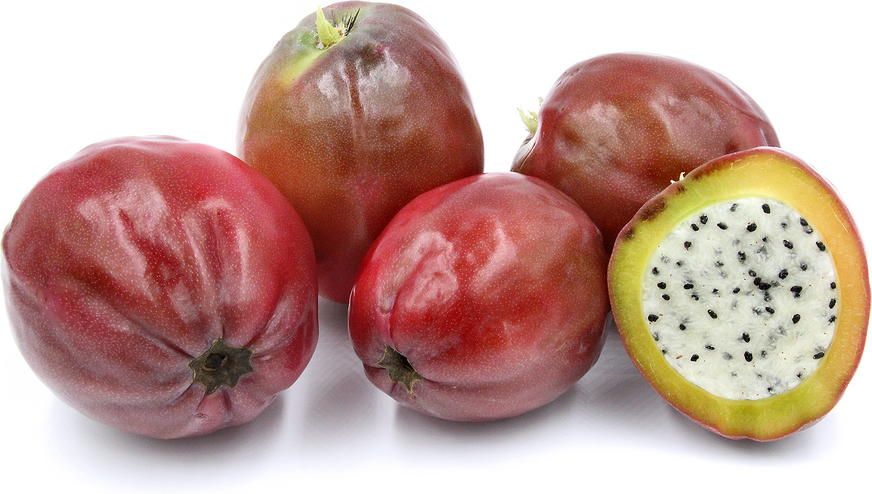


Peruvian Apple Cactus Fruit
Estimated Inventory, lb : 0
Description/Taste
The Peruvian Apple cactus is a slow-growing cactus that can reach heights of up to 15 meters. It features a relatively smooth, gray-green exterior with multiple branching arms adorned with sparse yet coarse spines. Oval-shaped fruits grow sporadically from its sides, ranging in color from brick red to bright magenta with occasional faint patches of yellow. The skin of these thorn-less drupes is speckled with tiny white dots and may bear a delicate, white residue. The outer texture is thick and somewhat leathery, similar to that of a Bosc pear. Just beneath the skin is a thick, bright yellow shell surrounding a white, fleshy flesh dotted with tiny black seeds, similar to those found in kiwis. The flesh is crunchy and juicy like shaved ice, complemented by a floral fragrance reminiscent of sugarcane. Its flavor is a harmonious blend of tart and sweet.
Seasons/Availability
Peruvian Apple cactus fruit is available from late summer to early fall.
Current Facts
The Peruvian Apple cactus, botanically classified as Cereus repandus, belongs to the Cactaceae family, alongside other cactus varieties. It is also known as the Hedge cactus, Giant Club cactus, Night Blooming Cereus, Kadushi, and Peruvian Tree Cactus. The genus name Cereus, Latin for 'torch,' likely refers to its white flowers that bloom at night, resembling flames atop its stem. Unlike most cactus varieties that grow in desert regions, this cultivar thrives in diverse environments throughout South and Central America. It produces a sweet fruit valued for culinary, ornamental, and medicinal purposes. Known as olala in Bolivia and pitaya in some regions, it should not be confused with dragonfruit, despite sharing similar names, as they belong to different species.
Nutritional Value
Peruvian Apple cactus fruit is rich in Vitamin C, which supports immune function, aids in white blood cell production, and strengthens the body's defenses against infections. The fruit's high beta-carotene content promotes good vision and may help reduce the risk of age-related macular degeneration. It is also a good source of dietary fiber, which supports digestive health by regulating bowel movements and aiding in weight management. In some regions, the green layer of flesh found between the cuticle and the firm yellow layer of the fruit is removed, dried under the sun or fire, and consumed to treat diarrhea. In the Goalpara District of India, Peruvian Apple cactus fruit is taken to alleviate cough. The fleshy leaves are roasted over fire and squeezed to extract the greenish juice, which is consumed for its medicinal properties.
Applications
Peruvian Apple cactus fruit is completely edible and often served raw, though it may also be used to make jam or compote. When chopped up, it can be served with fruit cocktails, yogurt parfaits, salsas, salads, seafood dishes, and poke bowls. The scoopable flesh can be incorporated into smoothies, milkshakes, cocktails, and sorbets. It can serve as an alternative ingredient in acai bowls by pureeing the frozen fruit and topping it with granola, honey, and assorted fruits. Peruvian Apple cactus fruit pairs well with limes, lemons, bananas, mangoes, apples, berries, chocolate, mahi-mahi, cod, kiwi, salad greens, salted pork, red peppers, and tomatoes. To prepare, select firm fruits that have no bruising and are just beginning to split open. The fruit should be refrigerated in a sealed bag and kept there for up to five days.
Ethnic/Cultural Info
The Peruvian Apple cactus is fast becoming an important cash crop in Israel, where water shortages are an increasing problem for the farming industry. The groves of cacti are now replacing old orchards that once required large amounts of water. The plant thrives in arid conditions, making it an ideal crop for regions with limited water availability. It can be harvested year-round, providing a continuous source of income for farmers. This year-round growing capability contrasts with many traditional fruit crops, which have specific harvest seasons, thereby offering economic stability and resilience against market fluctuations.
Geography/History
Despite the name, Peruvian Apple cactus fruits are native to Brazil, Uruguay, and Argentina. They are a hardy cactus that thrives in hot, arid climates but can withstand temperatures down to -6 degrees Celcius. In areas where summers are excessively hot and dry, some irrigation may be necessary to encourage healthy fruit production. The fruit of the Peruvian Apple cactus may be foraged in the wild or found commercially cultivated, especially in Israel. Though not a widely known plant, the Peruvian Apple cactus has achieved acclaim beyond its native region due to its versatility and ability to thrive in diverse environments. Its popularity has also increased as succulents have become more popular with the general public, sparking greater interest in gardening and planting. The Peruvian Apple cactus is most commonly found in nurseries. The fruit from the cactus is not widely recognized for its culinary uses and is unlikely to be found in grocery stores.
Recipe Ideas
Recipes that include Peruvian Apple Cactus Fruit. One
| Dina Fisher Foraging Guide |
|
Peruvian Apple Cactus |




